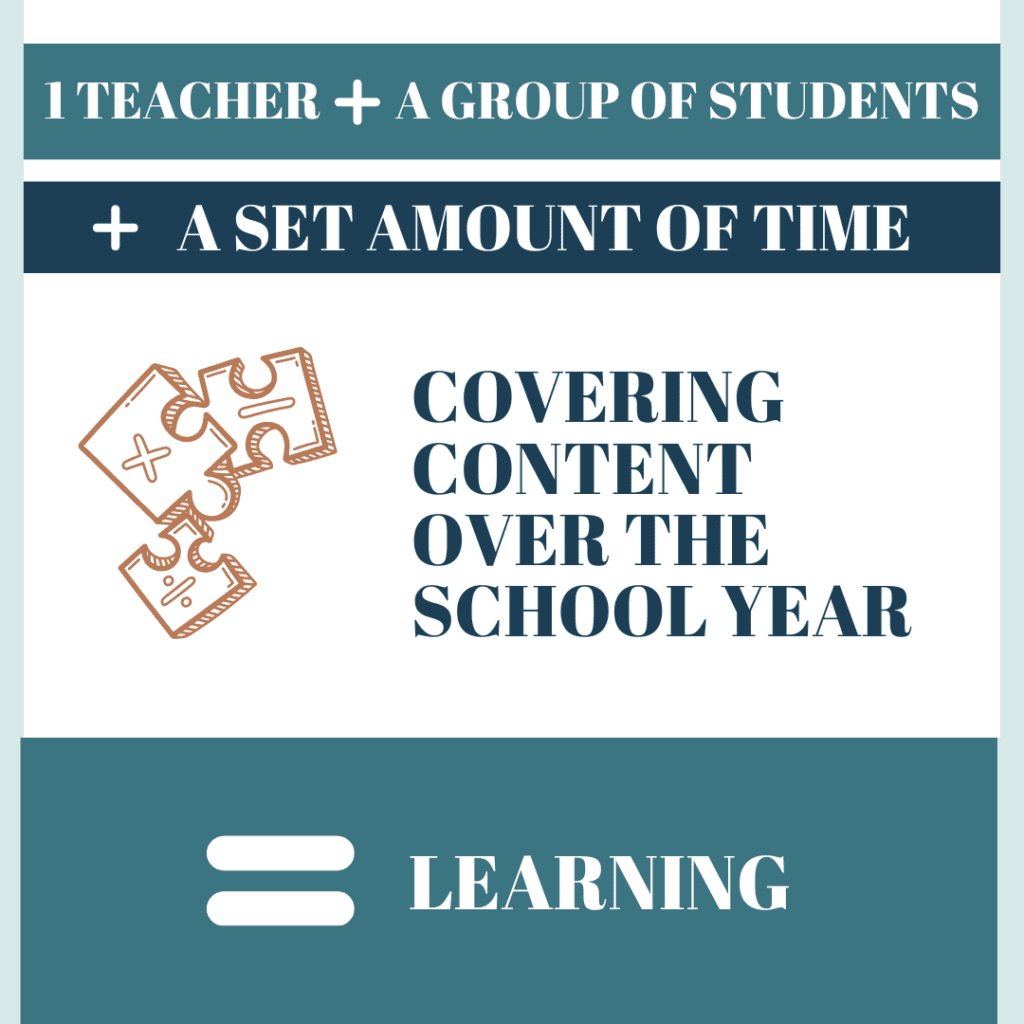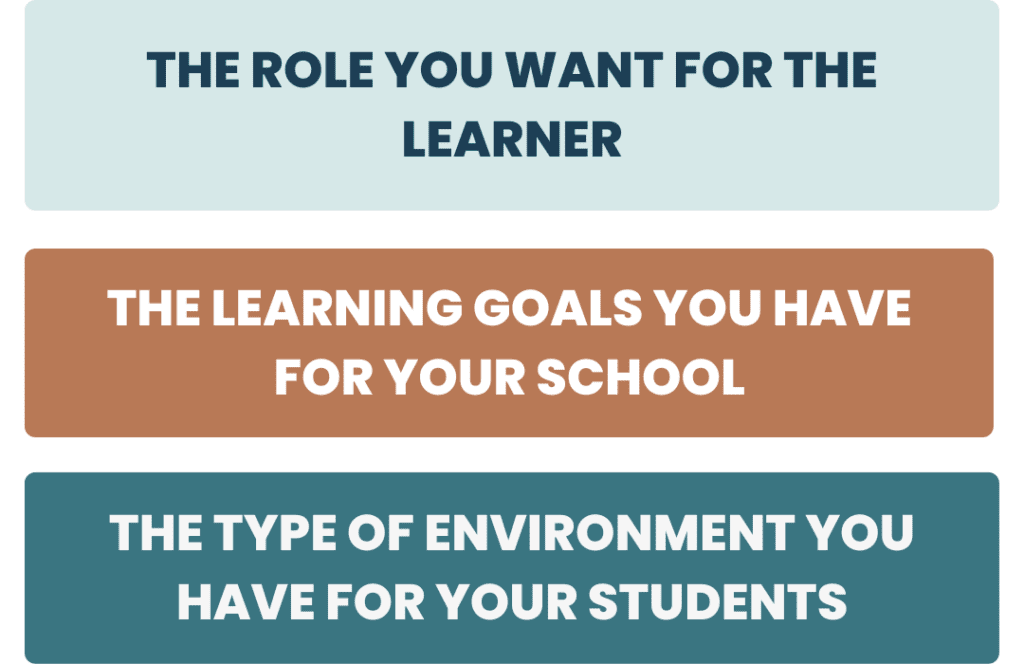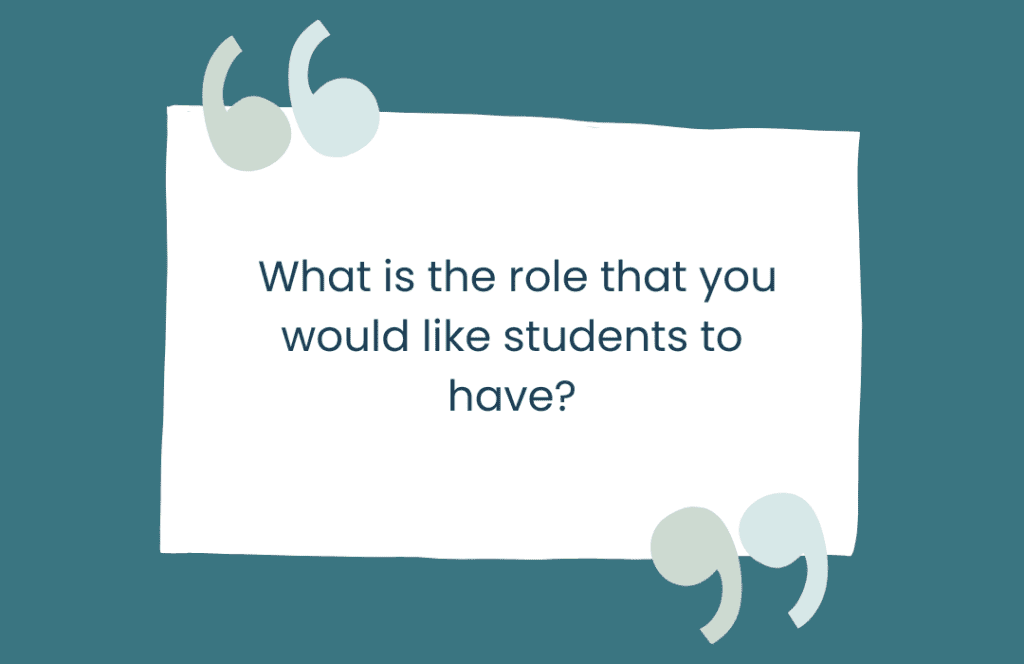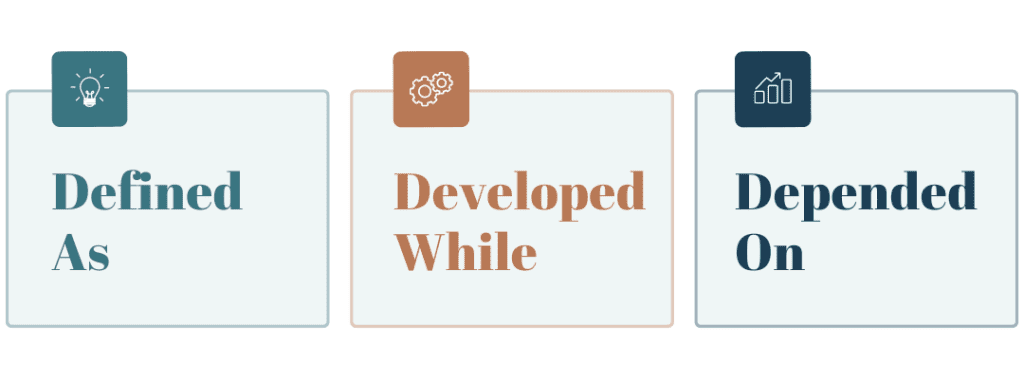Giving students greater opportunity for increased voice and choice, demonstrating mastery differently and designing experiences that are more responsive to meeting the needs of all students are necessary in today’s classrooms.
Most schools today still follow an industrial model. They are designed for instruction rather than the learner.
Shifting a system that’s been in place for over a hundred years isn’t easy.
It can feel like an overwhelming and daunting task. I think there is a much better way to start this shift that is simple, but systemic.
For the past 10+ years, I’ve been using and refining my approach to shift to a learner centered design in schools and districts across the country (including my own) that combines two key things:
- A high level of learning
- Nurturing powerful learners
Instead of looking at the shift to a learner centered design on a grand scale and trying to shift an entire system at once, this approach narrows in on how this process can be simple.
Simple enough that you can take a step with tomorrow’s lesson. Simple enough that you can understand it and move forward on it, but systemic in that as a team and group, each step you take towards a learner centered design really becomes a part of your larger journey.
The question, of course, is how?
I’m glad you asked.
Let’s dive in.
Starting Point
When you’re starting this process, it’s key to ask a few questions. One of the first questions is: What’s getting in the way when making the shift to a learner centered design?
As a team, you really want to identify:
- What you’re going from
- Where you’re going to
Essentially identifying what your starting point is, “We’re moving from this to this.” In this case, when you’re shifting to a learner centered model, you want to know where you’re starting from.
In this process, you’re designing for learning and when you reflect on where you’re “going from”, you might see that the current system was designed to be efficient or to deliver instruction.
It’s based on a schedule and not designed for the learner’s experience or for the learning outcome you want.
When you think about a starting point, you want to think about “where are we as team trying to get to?” More importantly, “where are we at today and why are we asking the question that we would like this to be a little more learner centered?”
Identifying the Function of the System
There is a great quote, “Every function has an optimal design.” This is a great pause moment for teachers, admins, and school leaders to dive deeper into the questions listed above.
In this moment, you and your team really want to think about the design of schools as they currently are.
In one way, their primary function might be to deliver instruction rather than to ensure learning. Going deeper…the idea is that sometimes schools are designed with a basic equation of:

This is the structure we find in a lot of schools. For example in a math classroom, you might stop and think, “Wow, we’re teaching math in the same classroom, at the same time, for an entire school year, with the same group of students at the same pace.”
When you take a step back from that, I think most people would see there are design flaws.
Asking Key Questions
When you look at this from the perspective that you want to shift from an instructional design to a learner centered design, you need to narrow in on:
- How can I design an experience tomorrow that gives students greater opportunity for increased voice or choice and to demonstrate mastery differently?
- How can I overcome some of the designs that are for instruction or an industrial model of school and move to designs that are more learner centered or more responsive to meeting the needs of students?
With these questions, a teacher could think, “I have a lot of constraints as I’m teaching here with my group of teachers.”
However, there are nuanced opportunities for teachers to simplify this and think about:
- How can I design this for learning where students have greater control of how they’re demonstrating their learning?
- Or greater control of the resources they want to use when they’re learning?
- Or even who they’re learning alongside – a teacher, a resource material or a peer group?
Sometimes it can feel like educators don’t have much control over the current system in place, but what they do have control over is the experience.
They also have control over how they can shift their role as educators and shift the role of the learner to have a greater sense of ownership, agency and responsibility.
How to Start the Shift to Learner Centered
After you’ve looked at your current school or district design to determine what it’s primary function is through the lens that it needs to place the learner at the center,
How do you now take that information and apply it to start to make the shift?
This is where the work has to be simple but systemic. Simple enough that you can take a step with tomorrow’s lesson. Simple enough that your team can understand it and you can move forward.
Systemic in that as a team or group, each step taken really becomes a part of your larger journey of three main things:

I’ve always said that S.I.M.P.L.E stands for the systemic implementation of powerful learning experiences. I have failed before in thinking that a school or district can do this on a grand scale right away, and really what this is about is tomorrow’s lesson.
Specifically, how can you make tomorrow’s lesson more learner centered and what small little shifts can take place. Starting small because it takes time for students to learn this skill, just as much as we say it takes time for students to learn how to read.
We give them 1,2,3,4 years and more as we think about the skills, like reading, that we want them to have. It takes time to nurture a powerful learner and have students take on these skills.
Defining the Learner’s Role
The first thing you need to do is define the learner’s role. To start this process, I like to do a classroom observation. I’ll go and observe elementary and high schools.
In classroom observations, the emphasis is always on what the teacher is doing. I flip that and just look at what the students are doing.
I try to identify what role the learner is in. Sometimes students will be sitting and receiving information and that’s not necessarily wrong, but you don’t want that to be their primary role all day. Sometimes I’ll walk in and see students doing something, homework, writing a paper, etc.
Other times I’ll walk in and see students owning the experience. In these cases, students won’t even notice me when I walk into the classroom. There is generally a bit of noise and I’ll see students advocating for themselves, they’re finding resources and they’re demonstrating their learning.
What is the learner’s role?
Now, this is my favorite part in this process, asking teachers:

If they can’t answer that question, then it’s a good spot to think about and explore.
The learning is going to be pretty instructionally centered if the teacher is in control of:
- What students are going to learn
- How they’re going to learn it
- How they’re going to demonstrate it
This is fine because this is where you’re shifting from. If teachers are further along that continuum of giving students voice and choice in their learning, then that’s where you would start from.
I would say that just as much as what you want students to learn, you should really be clear on what that means and what role you want them to play. Then, what happens is educators are able to identify what role they play.
Defining the Educator’s Role
As teachers and administrators are thinking about their role, positioning teachers as an academic success coach or as a guide on the side is key in a learner centered system.
Repositioning the teacher from being an expert on content to a facilitator of learning.
By doing this and shifting the students role you’re helping coach students to not just get the right answer, but understand their journey in self assessing and finding resources.
It’s subtle but overtime it really takes over.
Leadership’s Role as a Facilitator
As a school leader, I will often pull departments together and ask, “What is the role you want students to play in this experience and how can we design it?
It goes back to writing this down clearly and having it be just as much of a learning target as we would say the outcome is.
I’ve done this reflection piece a lot as a leader with a lot of departments and grade levels, in my own district and as a consultant around the country.
English class, math class, science class…you’ll often hear things like “I wish they would work collaboratively in groups”, or “I wish when they got stuck, they were able to find and navigate their way out.” Or, “I wish they could self assess and advocate for themselves.”
Most people won’t respond to that question with “I wish they would all get 100% accuracy on the next test.” What they usually do is talk about the learner’s role in the learning journey and the sort of engagement they would like to see.
I think we can all agree that a high level of learning from students is the goal. At the same time, when we think about the role we want students to play, we want a high level of empowerment.
Think about the knowledge of the learning you want and the skills you want them to have such as perseverance, communication, collaboration, self assessment.

When this happens, you’re starting to design learning for knowledge, skills and dispositions, and have students leave knowing that they are in control of their learning journey. They also have a sense of learnability that they can rely on tomorrow and for years to come.
Simple But Systemic Approach to Learner Centered Design
Defining the learner’s role is the first step in this simple, but systemic approach. Once you’ve done this, how can you design a learner centered experience focused on the students role?
With a model that I’ve developed over time and used in many schools and districts:

Let me explain.
Defined as: is defining what you want the learner’s role to be, so defined as what. Be really clear. Not everything, but one clear thing. I went in to a lot of detail above on this part, so I’ll be brief here.
Developed While: You’re going to develop what you’ve defined. For example, “defined as” is that you want students to be able to find resources for their learning. The goal is to develop this while students are learning and not in a separate class on being resourceful. Teaching students how to be resourceful is designed into the learning experience.
Depended On: The skill (identified in the previous step) is one that you believe students need to depend on in order to be successful in this classroom.
Let’s pull all of this together into an example:
In order to be successful in the U.S. history course, you want “defined as” to be a resourceful learner. This means you’re going to define it as that because that is what you defined the learner’s role as. You’re going to develop it every time you ask students to do a project and find resources, primary sources, and artifacts while they’re learning. Students will have a whole year to do that and they’re going to depend on it. Their success is going to be their ability to find great articles and resources for the history and the research that they’re doing in these projects. This is going to be a driver of their success in the course, and it’s not just about memorizing information.
It’s really about understanding the role that they can play and then it becomes a teacher teaching point.
Teachers aren’t in lessons sharing or delivering information but they’ve designed it so that students can go find the information and see themselves as not only achieving the learning target but becoming a powerful learner.
Having a great conversation and understanding the purpose, but also having teachers in every classroom really talk about the role they want students to have is the value add for the classroom teacher.
When a classroom teacher sees the role shift for students, it shifts their role generally into the position that they got into this profession for in the first place.
Most teachers won’t say I got into this profession in science to tell kids about science. Most teachers will say I got into this role to have students engage in science, to be part of it, to find discoveries, to share their thinking and really grow their passion for the experience.
That’s where you want to try to move again from a system that might feel like it’s trying to be efficient to one that is designed for learning and designed to empower learners.
How to Deal with Resistance and Overwhelm when Starting the Shift
Sometimes we get stuck in a pattern and we can put just as much energy into corralling learners to be engaged, to follow the lesson, and to do the work as if we shift the O.A.R (ownership, agency and responsibility) to their hands and empower them.
When this process feels overwhelming or you meet resistance, it’s really about answering the question as a team, “Where are we going to spend our time and invest our energy?”
There will definitely be people who question the shift to a learner centered design and there will be resistance especially with the implementation dip of students and teachers adjusting to new roles they may not have been in before.
When I was in my consulting role before, I had the chance to support the shift to a learner centered design in a lot of schools and with a lot of teachers.
When working in schools across the areas, I definitely had people that were ready to go and had established a great foundation to do this work. Others just hadn’t put themselves in this position or tried it before and it was a bigger leap.
In that case, I would go back to really asking and listening closely to what is the role you would like students to have and explore that. I have been in situations where I have asked a whole school, with over a hundred teachers, to try something just once.
I believe there is a big difference between zero and one. There isn’t much of a difference between one and two, but zero and one seems to stand out.
How High School Teachers Used a Learner Centered Assessment to Truly Get to Know Their Students
At a high school I consulted in, the teachers were talking about disengaged learners who didn’t really seem to care and there were some achievement issues.
As a staff, they picked one thing that they wanted to do. They said they wanted to shift the ownership into the hands of the learner for one assessment once a semester.
The staff wanted students to have greater ownership and greater engagement in learning. They took time to define what that means.
Everyone committed to turning over one assessment, something they controlled, to the students. Some people in the room had already done this and others hadn’t.
In shifting this over to students, there was a moment of trust for some of, “What are the students going to do?” and “How do I help them understand what they can do?”, and “Are they going to know the criteria?”, so on and so forth.
This work started in September and I went back in December to do a checkpoint of what worked, what didn’t work and what’s our next work. Some people shared pros and cons.
What was interesting is that many of the teachers struggled when they tried to get it over with and do it early in September and early in the school year. As compared to those that didn’t struggle when they did it near the end of the semester.
In breaking that apart, the staff uncovered those that did it at the end of the semester in November and December actually noticed that the students said “Oh, we did something like this in science.” or “Oh, we did something like this in art.”
They noticed that the more students had practice in shifting their role, the better they became at knowing how to look at the target and demonstrate their learning. Versus many students, who in September, weren’t asked to be in this role before.
The was a second benefit no one saw coming, but it made everyone want to do it the next semester. A lot of the teachers said:

Not a get to know you game, but they said they knew students in the hallway. They could look at the gifts they brought forward, look at their talents, background, passion, energy and see students share who they were and what they cared about in a variety of ways and it stuck.
It stuck in the hallway so they could say hello. They got to know their students better and that became the fuel for the second semester for teachers to do it again. Teachers only did this once and it was simple enough that they could get started.
In the second semester, they became more systemic and looked at where they could align as a department and started to see that students were developing the skill of greater voice and choice in how they demonstrated their learning.
The long journey was that teachers could see what students could do and they started to allow students greater choice in how they could learn and demonstrate their learning. That shift started to take place.
Take a Simple Step to be Able to Shift to a Learner Centered Design More Systemically
There is always some resistance in this process, but when you look at what you can do together, identify a starting point, and do one thing together it really helps you to see what worked, what needs work, and collectively what is our next work.
This example came from amazing teachers who were willing to try things. It’s key in this process to keep listening to what students need and what teachers need, but you really just want to take a simple step to be able to do this more systemically.
In some ways this can be an overwhelming process. I always go back to how every function has an optimal design. If your primary function is to deliver instruction then a traditional system is designed well for that.

Time and patience are key. We find ourselves in a system that has been built for over a hundred years with a lot of contracts and structures.
Generally you don’t flip your school all at once, which is why I like to focus on tomorrow’s lesson.
We can shift our thinking and really transform it into how we can be more designed for learning and learner centered. Really by shifting our thinking, finding a way to shift the experience, eventually we shift our system.
Want to bring Ryan to your school or district to support in the shift to a learner centered design?
Check out the Empowered Learning Institute for school-wide support on:
- Project Based Learning
- Student Voice & Choice
- Authentic Engagement
- Portrait of a Graduate
- Artificial Intelligence
- and more!
If this resonated with you, let us know. At Designed for Learning, we’d love to know if you plan to shift to a learner centered design and if you’ll implement Ryan’s approach in your school or district.
